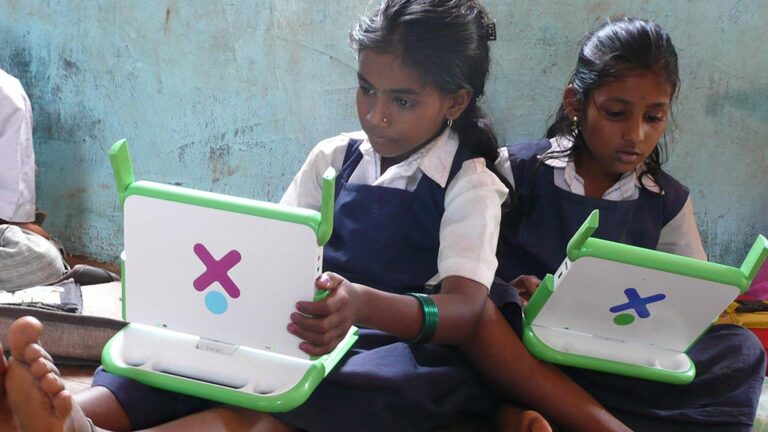New technologies have the potential to provide educational opportunities in underprivileged contexts. Examples from India, however, show that it is not only innovative technologies that are important, but innovative uses of technology.
Of all the innovations that have shaped the world of education in the past twenty years, none has been more exciting – or more controversial – than technological innovation. The classroom has become a digital space, the power of technology to engage children of all abilities and prepare them for an ever-changing workplace accepted as fact. Last year alone, the European Commission announced a Digital Education Action Plan and the Swedish government strengthened the place of digital skills in the national curriculum across every subject.
Further afield, the EU has also invested heavily in the ‘ICT for Development/Education’ (ICT4D/E) movement as a potential solution to the parallel challenges of teacher recruitment and growing demand for education in developing countries. Such attention has prompted a range of technologies that have immense potential in the fight to improve both access to and quality of education. But how far can technological innovations address the complex issues that shape a child’s education? Examples from India show the challenges involved.
One Laptop Per Child
The non-profit One Laptop Per Child (OLPC) was once the poster child of the ICT4D/E movement. In 2005, their plans to create a rugged, versatile laptop for just $100 caught the world’s attention. The opportunities that this would provide for children in the Global South were particularly exciting – armed with a OLPC laptop, children with otherwise limited educational opportunities would be connected to the digital world and all of the possibilities that it provides. Fourteen years later, this remains a key objective of OLPC: “When every child has a connected laptop, they have in their hands the key to full development and participation.”
The Indian government was one of OLPC’s first seven customers, but due to delays, revisions and rising costs, it dropped out in 2007 before the project was launched. Unperturbed by these challenges, Satish Jha, a journalist, corporate executive and a social entrepreneur, took up the project himself and has since worked to encourage India’s 28 state governments to sign up to OLPC. This flexibility of organisation – working with private as well as public entities – has helped OLPC to set up projects in 24 different countries today. It is also, however, a sign of the operational difficulties that have held back the spread of OLPC’s ambitious aims. In India, so far just 4 state governments have taken the project on board and fewer than 5000 laptops have been supplied.
Although Jha plans to continue expanding operations in India, a problem is perhaps the limited technological capacity of OLPC laptops. The ‘XO’ model has many benefits: its power usage is low, and its easily-replaceable rubber keyboard means it can cater for India’s 24 official languages. But, despite upgrades that increased costs and eventually made a $100 price tag impossible, the XO laptop still tends to pale in comparison to budget smartphones and tablets. Fears have also been raised that money invested in the laptops could be better spent on other resources, such as teachers, that as yet have a more demonstrable impact on the learning experience.
Hole in the Wall
While OLPC have tried to replicate the way in which technology is used in the West (private ownership, individual use), other initiatives have sought new paths. In 1999, Sugata Mitra, the academic said to the be inspiration for Slumdog Millionaire, embedded a computer into the wall of a slum in New Delhi. His aim was to provide ‘Minimally Invasive Education’ for children in areas where good teachers would not go. Within a few months, he found that local children, many of whom hadn’t seen a computer before, had not only learned to navigate its functions but had used it to learn about a range of subjects. His experiment launched Hole in the Wall, a project which today provides computers in playgrounds or other communal areas in a range of underprivileged communities.
To Mitra, the power of technology is not its technical specifications, but its ability to stimulate a ‘self-organised learning environment’ in which students work in groups to pursue educational goals relatively independently of the teacher. While further research is needed to study the long-term impact of the Hole in the Wall project, Mitra’s findings have shown promising effects on motivation, engagement, and retention of information when technology is used to stimulate group work.
E-learning
Excited by the ability of technology to improve educational standards, Mitra also launched the idea of a ‘granny cloud’ in 2014, enlisting the help of hundreds of British grandmothers to provide informal lessons to children in India via Skype. The use of volunteers to provide online lessons is an increasingly popular idea, fitting into a global trend of rising ‘e-learning’ in developed as well as developing contexts. Its potential to reach areas with limited resources is immense. However, studies have shown that, although e-learning increases enrolment rates, it also suffers from higher drop-out rates than traditional educational contexts. In response, calls to target broader social issues have arisen. Technology alone does not provide the broader support network needed to succeed.
So what do we know?
Technology helps to spread free, equitable education. It has the potential to contribute to the international community’s ambitious goal of providing quality education to all by 2030. However, as the case of India shows, the merits of technology need to be considered on a case-by-case basis. Technology cannot respond to all local needs or overcome all of the problems limiting educational quality in poorer contexts. What’s more, use of technology alone does not equate to creativity. The successes of Mitra’s projects and the limitations of OLPC suggest that it is not simply technology itself that has power, but how it is used.


